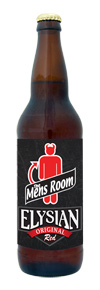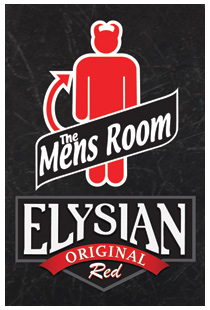
Beg Pardon?
Stay with me. Here we go.
Men’s Room Red is a beer made by Seattle’s Elysian Brewing. Elysian is a 19,000 barrel-per-year brewing company that began in 1996 as a single brewpub; after 12 years, in 2008, the company started getting serious about moving from on-premise to wholesale brewing, borrowing capacity from New Belgium in exchange for helping brew a small batch collaboration product for the Fort Collins, Colo.-based company in its own tanks in Seattle.
Elysian’s launch as a brewpub coincided with Seattle’s place as an early adopter in the craft beer movement, and its beers and pubs became something of a local fixture, growing as that scene did behind products like Dragon’s Tooth Stout and The Wise ESB.
But its best-selling beer didn’t emerge until several years later, when the company began to develop a relationship with a local afternoon drive-time radio show called The Men’s Room. As Seattleites, the hosts of The Men’s Room had begun to drink Elysian, occasionally mentioning it on the air. One day they were pre-gaming at the brewpub and were befriended by Elysian, CEO Joe Bisacca, who decided to brew a batch of product and named it after the show, calling it Men’s Room Red.
This arrangement worked well for the show hosts and for the brewery as well; on air, the show hosts began touting not just Elysian beer but Men’s Room Red. After selling 12 kegs the first night, the brewery reached out to the radio station and the two groups arranged for a portion of Men’s Room Red sales to be donated to a local branch of the Fisher House Foundation, which provides low cost lodging to veterans and military families receiving treatment at military medical centers.
The interest in the beer reverberated in the community. That was 18 months ago. Since then, the variety has taken off — the company sells about 4000 cases of .22 oz. bombers a month, as well as 600 kegs per month, and it has added about 400 draft accounts, according to sales and marketing director Matt Thompson.

But here’s the problem, which is one that’s emblematic of the way craft beer brands have grown:
“This story is great for the local market,” Thompson says, “But who is going to know about it in Pennsylvania?”
The answer is obvious — no one — but it begs another question, which is whether the way that craft is growing is one that is ultimately good when it comes to fulfilling the potential the category holds for the distributors, the retailers, or the suppliers themselves.
“The authenticity of regional brands and local brands has made for some that are very strong,” says Joth Ricci, the Managing Director at First Beverage Group puts it, “But in a lot of cases, it’s made it very hard for those brands to do what they call ‘travel.’”
Put more starkly, he adds, “One of the reasons you don’t have national craft beer brands is they don’t have the knowledge of how to break into a new, local geographic market.”
